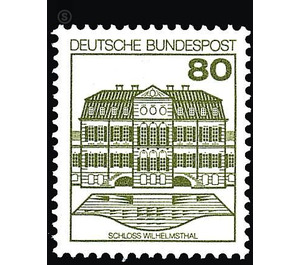Permanent series: castles and palaces - Germany / Federal Republic of Germany 1982 - 80 Pfennig
Theme: Architecture
| Country | Germany / Federal Republic of Germany |
| Issue Date | 1982 |
| Face Value | 80.00 |
| Color | olive |
| Perforation | K 14 |
| Printing Type | Lithography |
| Stamp Type | Postage stamp |
| Item Type | Stamp |
| Chronological Issue Number | 1013 |
| Chronological Chapter | GER-BRD |
| SID | 511358 |
| In 95 Wishlists | |
Supplementary values to the 1976/77 introduced roller-brand continuous series »castles and palaces«. The reel stamps appear simultaneously and identically with the inscription "Deutsche Bundespost Berlin". Schloss Wilhelmsthal, one of the most important works of the rococo, has a splendid facade and interiors of exquisite beauty. Landgravine Amalie Elisabeth of Hesse acquired in 1643 the farm estate Amelgotzen and established there a country castle. Landgrave William VIII built it since 1743 to a princely summer residence; since 1754 it has been called "Wilhelmsthal". The overall plan was created by François de Cuvilliés d. Ä. The park began in 1747, followed by the side wings in 1747, and the main building in 1753-56, most of which was equipped in 1770. Wilhelmsthal is a three-wing facility. The side wings are connected only by low intermediate pieces with the main building. Effective are height increase and gradation of buildings as well as the intersections of the lines in the oblique view. Unique is the richly articulated garden front with a forward middle section, old on similar side buildings and curved staircases: an excellent performance of the Rococo. The interior was decorated around 1756-61 in the Rococo style. The main rooms, in particular the stairwell, were designed by Cuvilliés. The stucco works are mostly by Johann Michael Brühl, the carvings of the wall paneling are based on designs by Johann August Nahl, who also worked for Sanssouci. (Text: excerpts from the texts of the German Castle Association e.V. Braubach - Dr. W. Avenarius)


